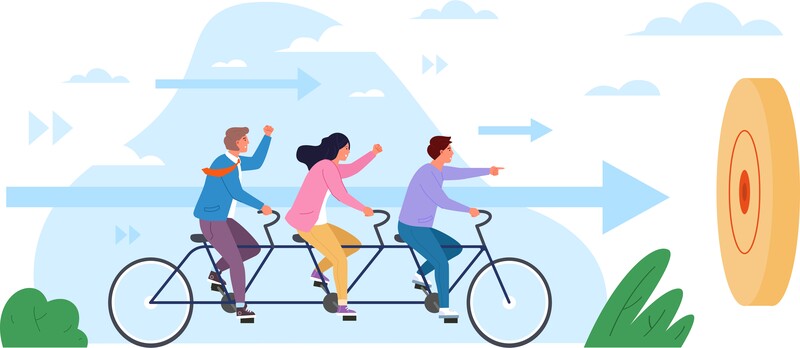Target Fixation: A Metaphor for Goal Achievement

Target Fixation: A Metaphor for Goal Achievement
Mardoche started to get interested in cycling. As he bikes, he started to appreciate more and more something so relevant to the work we do, every day, as clinicians. It is what we refer to in science as “Target Fixation.”
What is “Target Fixation”?
Target fixation is also known as “eye-steering.” It is a psychological effect that can influence our direction of travel, particularly when riding a bicycle or motorcycle.[1] Why does this happen? Here are the three main reasons why:
- Visual Attention[2]:
Our visual attention is closely linked to our body’s movement. When we focus our eyes on a specific object or point, our attention becomes fixated on that target. As a result, our body naturally tends to move in the direction we are looking.
- Balance and Proprioception[3]:
When riding a bike, our body relies on a combination of visual cues, balance, and proprioception to maintain stability and control. Looking in a particular direction can subtly shift our body’s balance and affect our steering input, causing the bike to lean or turn in that direction. Note that proprioception is awareness of body position. In other words, awareness plays a key role in maintaining such stability and control.
- Unconscious Steering Input:
The act of looking in a specific direction can trigger subtle unconscious movements in our hands, arms, and upper body. These small steering adjustments, often imperceptible to us, contribute to the bike naturally following the direction of our eyes.
Target fixation influences our steering and the control of the bike’s movement, not just through the above three mechanisms. Rather, also by affecting other factors, including:
- Our body positioning
- Our weight distribution
- Our intentional steering inputs
Awareness of target fixation is key; and by consciously directing our gaze where we want to go and practicing good riding techniques, we can improve our ability to control the bike effectively and navigate safely.
Now, how is this relevant to the work we do? Well, everything we do with our clients is goal-based, whether we are aware of that or not. As a result, goal achievement is key to the work we do with our patients. This is despite the fact that we, clinicians, have not been formally trained in the area of goal achievement.
Now, what is the relationship between target fixation and goal achievement?
Let us look:
Goal achievement is a fundamental aspect of growth, development, and success. It involves:
- Setting clear objectives
- Charting a path
- Making progress toward desired outcomes
Interestingly, the phenomenon of target fixation, often observed in activities like cycling or motorcycling, as discussed above, can serve as a powerful metaphor for understanding and achieving our goals and guide our patients and clients to do the same. Let’s explore how target fixation relates to goal achievement and the lessons it offers along the way.
The Power of Focus[4]:
In target fixation, the direction of our eyes and focus influence our path of travel. Similarly, in goal achievement, a clear focus on our desired outcome plays a pivotal role. By setting specific goals and maintaining unwavering attention on them, we increase our chances of reaching them. Like a cyclist intently staring at a target, our focused attention directs our efforts, decisions, and actions toward the realization of our goals.
Harnessing the Unconscious Mind:
Target fixation triggers subtle unconscious movements in our body, guiding us in the direction we are looking. In goal achievement, our unconscious mind also plays a significant role[5]. When we deeply internalize our goals and maintain an optimal mindset, our unconscious mind becomes aligned with our objectives. It drives us to take action, make choices, and seize opportunities that bring us closer to our desired outcomes, often without us consciously realizing it.
Overcoming Distractions and Obstacles:
During target fixation, excessive fixation on obstacles rather than the desired path can lead to accidents or deviations. Similarly, in goal achievement, distractions, and obstacles can divert our attention and impede progress[6]. By staying focused on our target and cultivating resilience, we can navigate around obstacles and remain on track. We learn to acknowledge distractions without losing sight of our ultimate destination.
Balance and Adaptability:
In target fixation, balance is crucial for maintaining control and staying on course. Likewise, in goal achievement, finding balance in our efforts, resources, and priorities is essential. Balancing dedication with self-care, perseverance with flexibility, and short-term milestones with a long-term vision, ensures sustained progress and adaptability[7]. It enables us to adjust our approach when needed without losing sight of our ultimate goal.
Celebrating Milestones:
During target fixation, as a cyclist reaches intermediate targets, they experience a sense of accomplishment and motivation to keep going. Similarly, in goal achievement, acknowledging and celebrating milestones along the way provides a boost of motivation and reinforces progress. By recognizing and appreciating each step taken towards our goals, we cultivate a positive mindset and the drive to continue forward.
Target fixation serves as a powerful metaphor for goal achievement, teaching us the importance of focus, harnessing the unconscious mind, overcoming obstacles, maintaining balance, and celebrating milestones. By applying these lessons to our pursuit of goals, we can maximize our chances of success. As we fix our gaze on our desired outcomes, remain adaptable, and steer clear of distractions, we empower ourselves to navigate the path to achievement with determination, resilience, and unwavering focus.
Isn’t this an idea worth sharing with our colleagues, our mentees, and more importantly with our patients and clients? And, please come and engage in experiential learning, through the SWEET Model, by attending one or more of the following seminars this week:
- Social Work Code of Ethics
- Mastering Genograms
- Cognitive Distortions and Our Clients
- Mastering Case Formulation
- The Psychotherapy Certificate Course (Self-Study)
Also, join us for our upcoming CBT for PTSD Virtual Conference.
[1] Bobrova, E. V., et al. “Comparative analysis of the dynamics of human postural control during fixation and pursuit of a visual target.” Biophysics 52 (2007): 248-252.
[2] Samiei, Manoosh, and James J. Clark. “Target Features Affect Visual Search, A Study of Eye Fixations.” arXiv preprint arXiv:2209.13771 (2022).
[3] Irrgang, James J., Susan L. Whitney, and Emily D. Cox. “Balance and proprioceptive training for rehabilitation of the lower extremity.” Journal of Sport Rehabilitation 3.1 (1994): 68-83.
[4] Hagstrom, Robert G. The Warren Buffett portfolio: mastering the power of the focus investment strategy. John Wiley & Sons, 2000.
[5] Custers, Ruud, and Henk Aarts. “The unconscious will: How the pursuit of goals operates outside of conscious awareness.” Science 329.5987 (2010): 47-50.
[6] Dienstmann, Giovanni. Mindful Self-discipline: Living with Purpose and Achieving Your Goals in a World of Distractions. LiveAndDare Publications, 2021.
[7] Burns, Emma C., Andrew J. Martin, and Rebecca J. Collie. “Adaptability, personal best (PB) goals setting, and gains in students’ academic outcomes: A longitudinal examination from a social cognitive perspective.” Contemporary Educational Psychology 53 (2018): 57-72.








